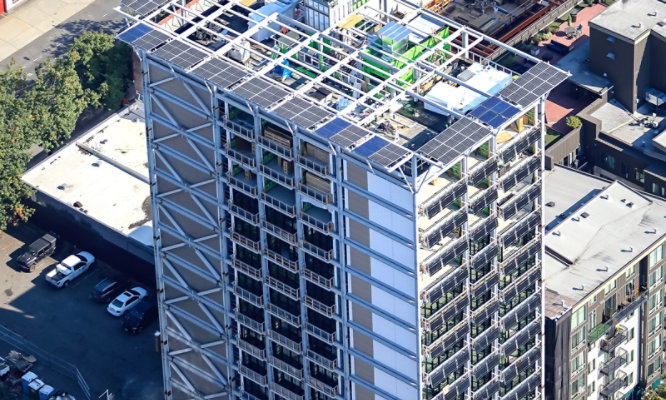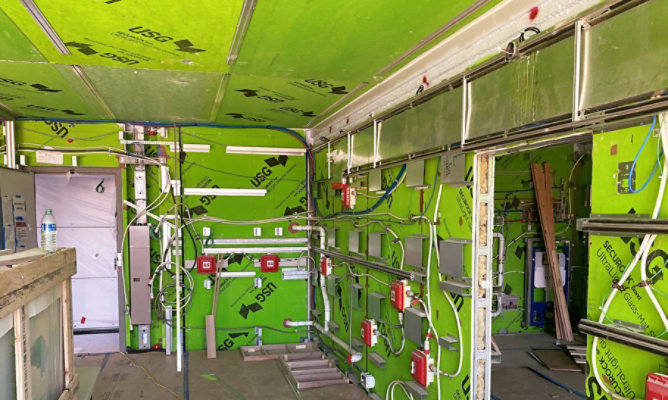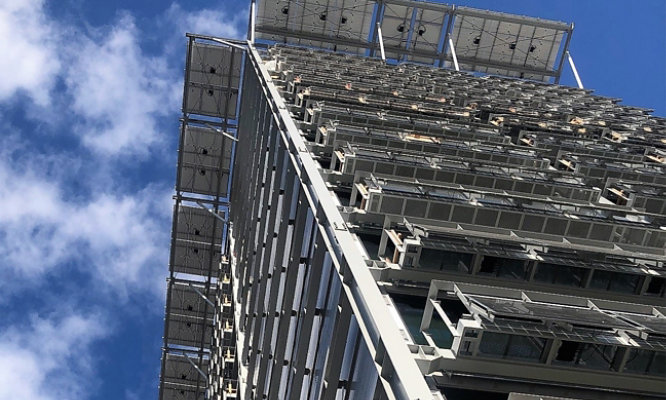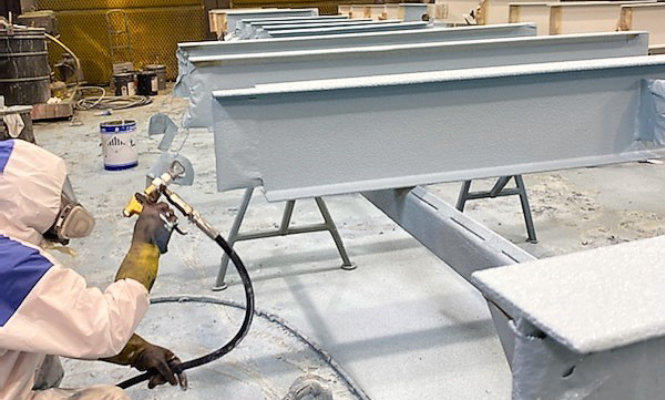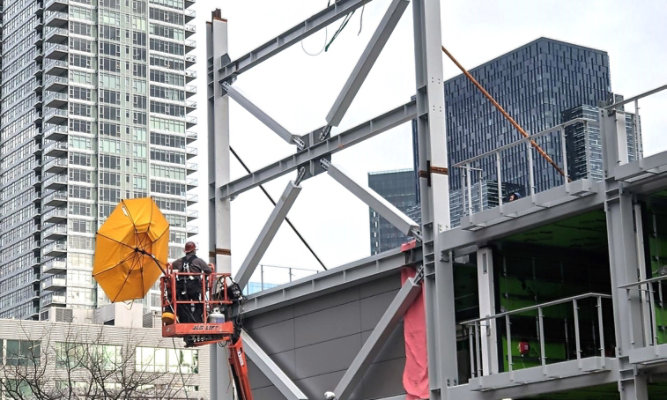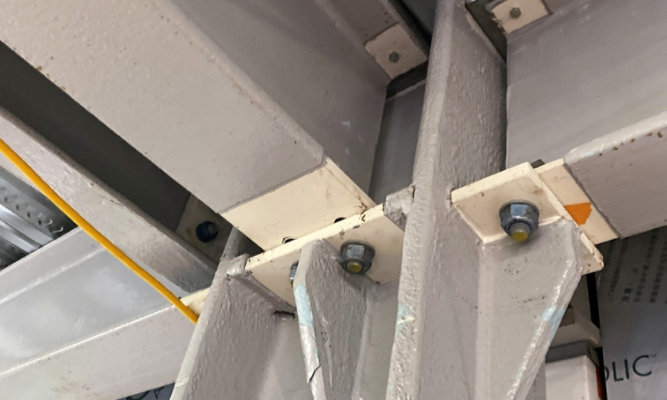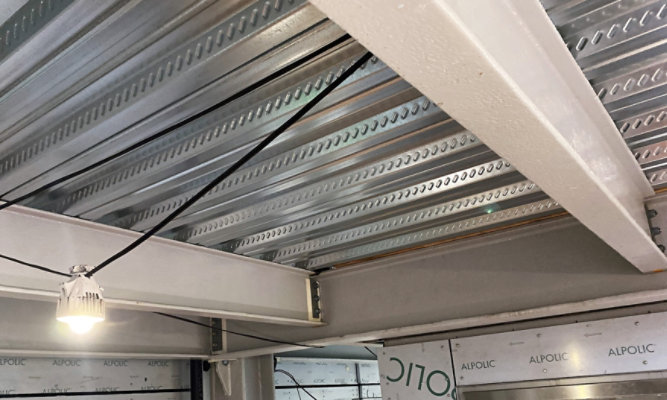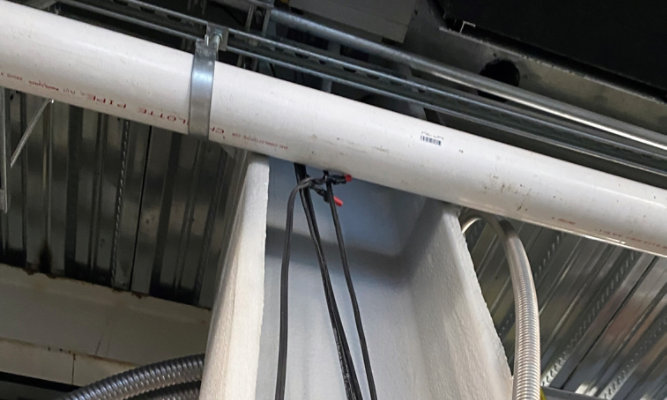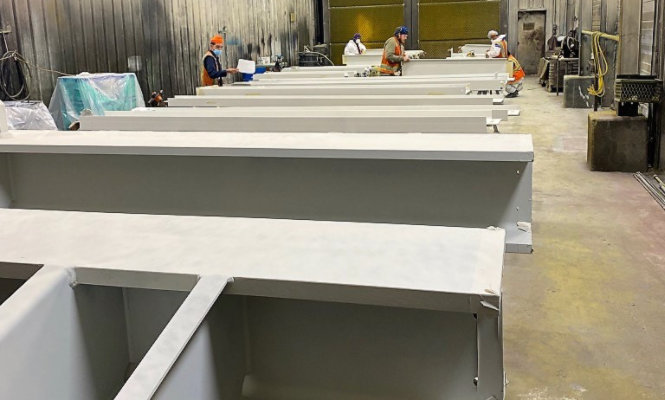Offsite Fireproof Coating Application Promotes Construction Efficiencies and Sustainability
303 Battery Building a Feat in Productivity – and a Template for Modern Steel Construction
by Max Tritremmel, Fire Protection Market Segment Director – The Americas, Sherwin-Williams Protective & Marine
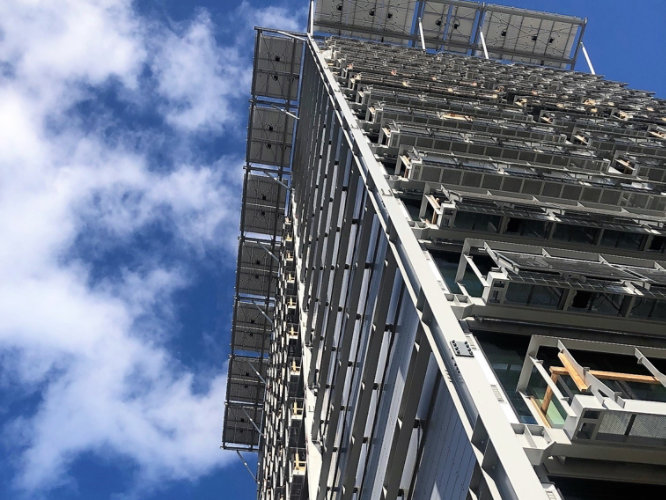
A new method of designing and building high-rise buildings is revolutionizing the construction industry, and the simple act of moving steel coating application from the construction site to an offsite facility is a critical factor – while also allowing developers to erect buildings on previously impractical parcels.
This method, involving extensive prefabrication, is faster, more efficient and sustainable than conventional approaches. Much of the work is done offsite, with the construction of wall and floor panels that already contain heating, electrical and plumbing infrastructure, along with architectural finishes. Shipped to the construction site, the panels are assembled like Legos and then fastened together and to the building’s structural steel exoskeleton.
With these efficiencies, a project that would normally take two years to complete can take half that time. Less material is wasted, and construction vehicles make fewer trips.
Sustainable Living Innovations (SLI) used this method to construct 303 Battery – a 15-story, 112-unit apartment complex in Seattle. At its Tacoma, Washington, factory, the company built nearly 1,000 utility-packed wall and floor panels for the project – the first high-rise apartment building in the world expected to meet net-zero energy standards established by the International Living Future Institute. That means the building will produce 105% of the energy it consumes – by using solar panels and heat-recovery devices, recycling “greywater” and implementing other sustainable systems.
While SLI had already optimized the construction of prefabricated panels, the company needed to determine the best way to manage the production and erection of the building’s structural steel.
Integral to the design aesthetic was the use of architecturally exposed structural steel (AESS), which reduced the need for drywall, cladding and other materials. Still, all steel members needed coatings for protection – some with only an anti-corrosive primer and others requiring the primer plus fireproofing coatings and/or an aesthetic topcoat.
Coating steel at the construction site would not be feasible due to its small footprint, as well as the extra costs that would be required to erect a makeshift coatings shop and maintain the climate inside. To overcome these limitations, SLI knew shop coating applications would be required.
The developer discovered a fireproofing coating that matched its construction method’s emphasis on speed, economy and environmental friendliness.
The intumescent product, Firetex® FX9502 from Sherwin-Williams Protective & Marine, required lower installed thicknesses compared to other coatings – helping designers showcase the steel’s attractiveness – with faster application and curing times, plus significantly lower costs. To further boost aesthetics, the application shop – Seattle-based Puget Sound Coatings – also applied an aesthetic topcoat of Sher-Loxane® 800, another Sherwin-Williams product, on any visible steel.
All coatings applications were completed offsite, except for finishing work where structural steel would be connected on-site. The efficiency of offsite application proved integral to the project, which involved more than 2,000 structural steel pieces and hundreds of prefabricated panels assembled by a small crew in about eight months.
“If the project was performed conventionally onsite, it may have taken twice as long,” said Carrie Cassidy, SLI’s Chief Construction Officer. “Coating steel offsite contributed significantly to time savings.”
Offsite Application Streamlines Construction
Marcus Miller, SLI construction manager, noted the company had several reasons for applying steel coatings offsite.
First, the construction site was a tight space, at 6,400 square feet, and was an isolated “orphan lot” surrounded by existing buildings. To build a temporary painting booth during the structural build would have required precious space. The company could have instead opted to erect the steel first and spray fire protection onto beams, columns and braces. However, this process is more time consuming, costly and does not ensure an aesthetically pleasing finish. It would also require using containment tarps and masking off connected panels – adding time and cost.
Second, weather would have made applying coatings onsite burdensome. Thanks to a winter construction schedule, a makeshift booth would have required strict temperature and humidity control. Applying fire protection in an offsite shop allowed the coatings to cure in a climate-controlled environment, providing a greater likelihood for high-quality applications.
“This project wouldn’t have penciled if we had to tent the whole job, heat it and paint intumescent coatings onsite in a Seattle winter,” said Miller.
Third, applying fire protection in a shop was safer for workers and the environment. Onsite applications would have released solvent emissions into the densely populated area nearby. And if the steel had already been erected before coating, workers would have had to work from potentially perilous swing scaffolding.
All this added up to the fourth reason for choosing offsite coating applications: It was faster and fit a condensed construction schedule.
Specifying an Economical Fireproofing Solution
Some trial-and-error quoting from different application shops for fireproofing coatings led SLI to work with Puget Sound Coatings and Sherwin-Williams.
The economies that Firetex FX9502 offered, including reduced dry film thickness (DFT), faster application and curing, and better aesthetics compared to alternative options, sealed the deal.
For example, when using Firetex FX9502, the coating build required for the two hours of fire protection specified for 303 Battery ranged from 43 mils to 225 mils DFT. Applicators were able to apply fewer coats of Firetex FX9502, and the steel moved through the shop faster – also translating to lower labor costs.
Given these efficiencies, SLI was able to coat a tier of structural steel (two building floors worth) in just three weeks.
To ensure Firetex FX9502 would meet the required aesthetic standard, Puget Sound Coatings prepared mockups to confirm the coating’s smooth appearance provided an attractive finish.
“We wanted to avoid the look of inflated steel where coatings balloon in the middle and thin out near edges,” said Miller. “Having a thinner coating than the competitors’ products provided superior aesthetics.”
SLI also appreciated Firetex FX9502’s low ratings for volatile organic compounds and toughness.
“The steel was loaded onto trucks and handled in the field,” said Miller. “Having a durable coating – that didn’t crack or fall off when hit with a sledgehammer – was critical.”
Coating Efficiencies Boost Shop Throughput
Puget Sound Coatings’ first step in the application process was to blast steel to the SSPC SP-10 Near-White Metal-Blast Cleaning standard, removing dust and other material with recyclable steel grit.
Then, applicators used a single-leg pump to coat AESS members. Applicators first sprayed Sherwin-Williams Recoatable Epoxy Primer, a two-component, rust-inhibitive coating designed for fast drying, at 2.5 to 5 mils DFT. The longevity of the primer’s recoat window was critical for 303 Battery, as some steel included holdback areas where fire protection would be applied at the construction site. Due to the primer’s long recoat window, these surfaces did not need to be re-prepared before adding additional coatings.
“Recoatable Epoxy Primer is a barrier coating,” said Brian Wiehle, President and Co-owner of Puget Sound Coatings. “It prevents corrosion and serves as a holding primer. You can apply Firetex FX9502 directly to surfaces after a SSPC SP-10 blast, but applying that primer was like insurance and made sure our blast held.”
Next, layers of Firetex FX9502 were applied the day after the primer coat. For thinner and relatively weaker pieces of steel, applicators sprayed Firetex FX9502 in multiple thin coats to reach a DFT of 225 mils. For some of the larger and thicker steel pieces, which would take longer to weaken in a fire, only a 43-mil DFT coat was required, which was conservatively sprayed on in two coats to maximize aesthetic appearance.
To ensure a smooth application process, especially since Puget Sound Coatings had never used Firetex FX9502 before, Sherwin-Williams dispatched a technical service representative to the shop. The tech ensured applicators were established with quality control, which carried through to the final coated steel.
SLI and Puget Sound Coatings could have stopped with the Firetex FX9502 application but chose to enhance the steel’s appearance and protect the fireproofing coating with Sher-Loxane 800. This versatile, high-performance epoxy-silicone hybrid provides long-term corrosion control and, because of its pleasing appearance and durability, is typically the topcoat of choice for high-visibility projects like 303 Battery. The shop applied a gray, semigloss layer of Sher-Loxane at 4 to 7 mils DFT on all exposed structural steel.
As for any nonexposed structural steel, only the zinc-rich primer and Firetex FX9502 coatings were applied. Any exposed nonstructural steel received only zinc-rich primer and a Sher-Loxane topcoat, as that steel did not require fire protection.
The entire application process took about three days for each steel piece. Puget Sound Coatings left most coated steel in spray booths for one day to complete curing. Then, workers moved members to the finishing yard, where steel remained until needed at the construction site.
A Bright Future for Modular High-Rises
SLI was thrilled with the quality of the Firetex FX9502 applications. Having inspectors read coating thicknesses in the spraying booth was more accurate and efficient than measuring coatings on steel already erected at the construction site.
“The quality control was unmatched,” said Matt Trueblood, SLI’s Constructability Manager. “Several inspectors have been impressed with the application and product.”
SLI will continue employing the exposed steel exoskeleton concept as its staple construction method.
“We are creating the buildings of the future,” said Cassidy. “With a declining cost curve compared to traditional construction, we’re on the cutting edge. We’re proud Sherwin-Williams is a part of it.”
ABOUT THE AUTHOR
Max Tritremmel is Fire Protection Market Segment Director – Americas for Sherwin-Williams Protective & Marine. For more than 26 years, he has served the coatings industry as a sales representative, business leader, industrial painting contractor and now marketer. He is an SSPC Protective Coatings Specialist and an SSPC Level 3 Certified Coatings Inspector. Contact: Max.Tritremmel@sherwin.com
Our Water & Wastewater Expertise
Explore our industry solutions and technology to help protect your assets.
LEARN MOREProduct Lookup
Find out more about our innovative coatings for a variety of industries.
FIND A PRODUCT